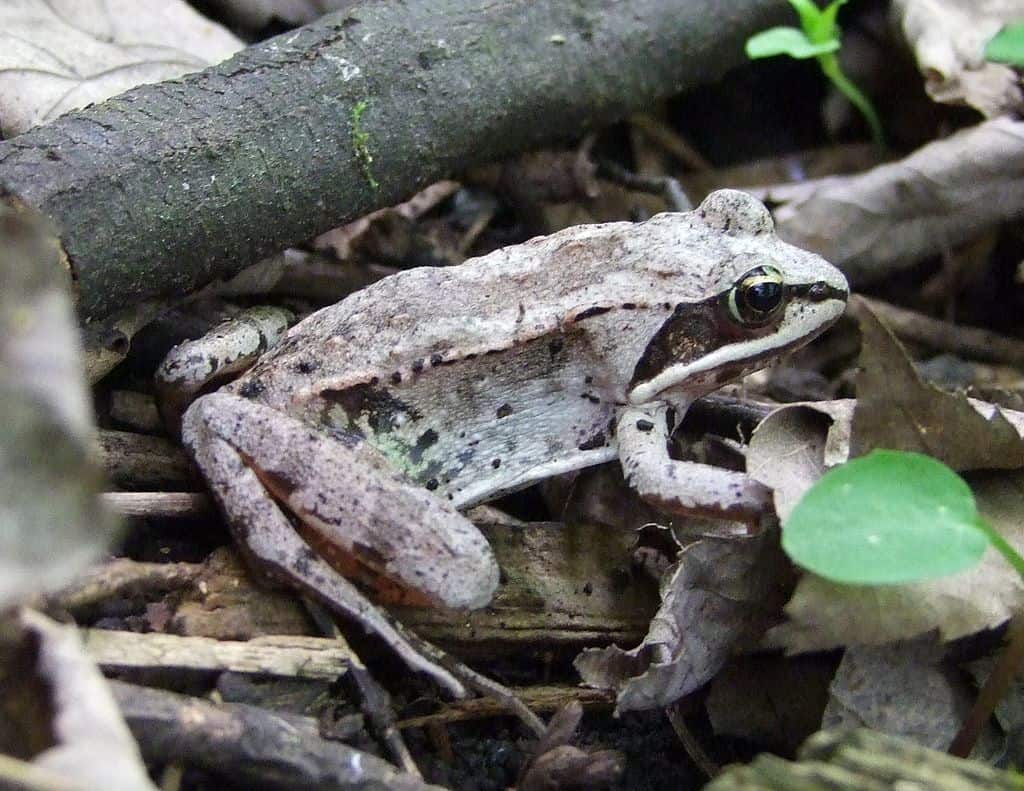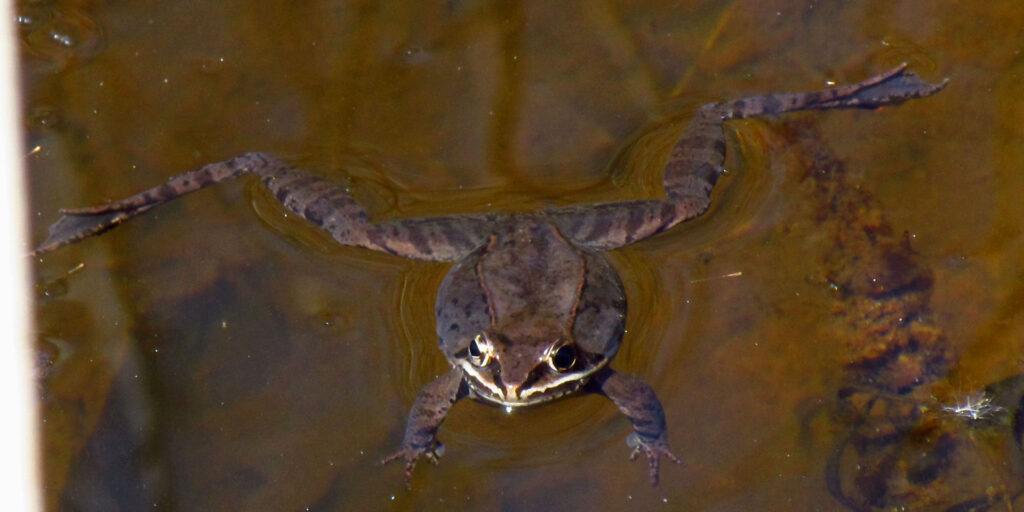The Alaskan wood frog is the only North American amphibian species that lives within the Arctic Circle. In the wintertime, subzero temperatures occur daily in the arctic. Amphibians normally prefer warmer regions.
Alaskan wood frogs are also the only frogs in North America that can survive in this kind of conditions. They accomplish it by entering a state of suspended animation and allowing themselves to freeze.
To all appearances, they seem dead. However, in the early spring, they will thaw out and start moving around again. For all intents and purposes, they are unharmed by the harshest conditions of interior Alaska.
New research has discovered some fascinating things about these creatures.
Wood Frog Characteristics
The Alaskan wood frog is just one branch of the common North American wood frog (Rana sylvatica) (sometimes called Lithobates sylvaticus). There are wood frog populations found from Northern Georgia to Northern Canada and Alaska.
Wood frogs are 2 to 2.8 inches in length. Their bodies are tan to rust colored with cream, tinged with
yellow or green colored underparts. Additionally, most wood frogs have a dark brown eye mask.
Wood Frog Behavior
Wood frogs spend most of their time in their natural environment, which is on forest floors. This gives rise to their common name, “wood frog.” They tend to be solitary and don’t roam around much. In fact, they spend most of their lives within a single 300 by 300-foot piece of real estate. They spend their time hunting for slugs, snails, insects, insect larvae, and arachnids to eat.
Due to their small territories and solitary habits, different populations of wood frogs don’t interact much.
In early spring, however, after they emerge from hibernation, they throw off their usual habits and gather together at their vernal pools to breed. They’ll travel more than 3,000 feet to reach these breeding pools. This is a short migration by human standards. However, it’s an enormous distance for these small frogs.
Vernal pools, by definition, don’t exist year-round. Consequently, they don’t contain any fish. This makes a safer environment for both the frogs and the egg masses they leave behind.

Wood Frog Adaptations
Alaskan r. sylvatica are very similar to Ohioan frogs or any of the wood frogs found elsewhere on the continent. However, they do possess some slight variations that help them survive the big freeze of an Arctic winter.
All wood frogs enter a state of ametabolic suspended animation to survive through the cold winter months.
However, Alaskan wood frogs and wood frogs in northern Canada survive much harsher conditions than do wood frogs from the Midwestern United States.
This yearly freezing isn’t the only odd thing about wood frogs, though. They’re pretty strange as tadpoles, too. To discourage predators, wood frog tadpoles grow a poison gland.
Interestingly, they lose this poison gland when they become adult wood frogs. Adult wood frogs emit pungent skin secretions that help protect them from shrews and other predators by making them taste really bad.
Poison glands and pungent skin secretions aren’t the only protective adaptations these frogs have.
They are also capable of emitting surprisingly loud screams. These screams are designed to startle predators and allow the frogs to escape. This it’s not much like their ordinary sound. It’s more of a loud duck-like quacking sound.
They also have colored patterns on their backs that help them blend into the forest floor so that predators can’t see them so easily in all the leaf litter.
It is the yearly freeze and thaw cycles that really get people’s attention, though. It’s an amazing response to deadly low winter temperatures. These frogs can’t generate enough body heat to live through the long winter, so they kind of don’t. Instead, they allow themselves to freeze. However, just letting themselves freeze would prove fatal because water expands when it freezes. This would burst all the cells in the frog’s body as the liquid in them turns to ice.

Alaskan Wood Frog Study at the University of Fairbanks
Dr. Brian Barnes, who is director of arctic biology and graduate student Don Larson of the University of Alaska Fairbanks, published a study in 2014 on how Alaskan wood frogs survive the harsh winter season. These scientists studied the behavior of free-living wood frogs in natural conditions and used standard lab-based experiments to explain that behavior. See
Alaskan wood frogs remain in suspended animation for up to 7 months. As temperatures start to drop to the freezing point, the frog’s heart stops, and its body releases glucose and glycolipids. The researchers also found that the frogs don’t actually just freeze and thaw once. They actually freeze and thaw out several times as the temperature drops.
Such freeze-thaw cycles cause significant physical changes. Glucose levels skyrocket, and the antifreeze glycolipids along with them. These glycolipids are special proteins that act as a type of antifreeze. They, along with the high glucose concentrations, prevent the formation of ice crystals inside their cells. They instead keep their contents in a liquid state.
Up to two-thirds of their body water freezes. However, it does so in the right places and the in right ways. Consequently, the individual cells of the body escape being damaged.
The frog’s body temperature can then drop well below the freezing point, and no physical harm will come to it. Because metabolic activity has almost completely stopped, the frog no longer needs food. What’s more, the ice preserves their organs and tissues through the harsh winter.
Subsequently, as late winter transitions into early spring, which is around early March, things start to change. As the colder temperatures come to an end, the antifreeze in their blood starts to break down. After that, normal metabolic activity returns.
When it’s warm enough outside to support normal life activities, the frogs come out of their state of suspended animation and immediately begin their mating cycle.
Miami University Study
Richard Lee and Jon Costanzo, who are both Doctors of zoology at Miami University in Oxford, Ohio, authored an additional wood frog study. That appeared in the August 21st, 2013, edition of the Journal of Experimental Biology. See
This study compared the differences in the abilities of wood frogs from southern Ohio and Alaskan wood frogs to withstand cold winter temperatures.
The researchers artificially reduced the length of the photoperiod and incrementally reduced temperatures in the lab to simulate the change of seasons from early autumn into deep winter.
Once the frogs became acclimatized, the researchers kept the frogs in simulated hibernation at 4°C for 8 weeks. The Alaskan frogs and the Ohioan wood frogs were kept under the same conditions for a side-by comparison.
The team tested the Alaskan wood frogs’ freeze tolerance compared to the wood frogs from Ohio. They found that the Alaskan wood frogs recovered much more quickly than the Ohio wood frogs after being frozen and thawed out again under the same conditions.
Study co-author Jon Costanzo reports that the frogs’ bodies actually broke down muscle protein in order to get at the useful nitrogen it contains. They used it to produce the urea that their remaining, slow metabolic processes produce as waste. Urea is the main waste product of all metabolic processes.
The researchers also discovered that the livers of the Alaskan wood frogs accounted for 22% of their total mass. This compares to 8% for the Ohioan wood frogs.
The researchers deduced the reason for this is that the Alaskan wood frogs used their body fat and some of their muscle protein to produce glycogen. Which is a precursor to producing glucose. Glucose is a cryoprotectant that their bodies mobilize when they begin to freeze.

Alaskan Wood Frogs in Human Medical Research
This University of Alaska and Miami University research is important to the research in human medicine. There is some thought that the extreme freeze tolerance in Alaskan wood frogs holds the key to the long-term preservation of human organs. This could potentially save many lives.
Every year, thousands of people’s lives are saved by organ transplants. However, for every person saved, several are lost due to a lack of available organs. A big part of why that is so is because doctors have no effective way of preserving human organs long term. So not only do organ donors need to be available, but they also need to be located fairly close to the people who need the organs, and that frequently doesn’t happen.
The internal organs of these freeze-tolerant frogs don’t suffer any damage despite spending an entire season frozen in ice. It is possible that the antifreeze compound produced by these Alaskan wood frogs could be used to preserve human organs as they become available, to be stored until needed for an organ transplant. They could also be shipped long distances, even sent to people in need all over the world. This could potentially save a lot of people’s lives. Research is planned to see if this natural antifreeze can preserve tissue samples at frigid temperatures for long periods without any damage.
These frogs are very common. Yet their strange method of surviving the cold Alaskan winters is most unusual. They’re certainly fascinating little creatures, and who would have thought that the study of frog survival in cold climates could possibly end up having such incredibly positive implications for human life?
Recent Posts
The only venomous snakes in Washington State are Northern Pacific Rattlesnakes. The Northern Pacific Rattlesnake (Crotalus oreganus oreganus) is a sub-species of the Western Rattlesnake. Anyone...
Skunks are not classified as true hibernators. But they go into a state of torpor when the weather gets cold. Skunks are light sleep hibernators, along with opossums, bears, and raccoons. ...
